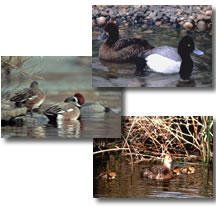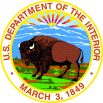
U.S.
Fish and Wildlife Service, Division of Migratory Bird Management,
U.S. Geological Survey, Patuxent Wildlife Research Center
Hunter Activity & Harvest Data
Duck Stamp Sales
Since 1934, when the Migratory Bird Hunting Stamp went into effect, all waterfowl hunters 16 years old and older have been required to carry a Federal Migratory Bird Hunting Stamp, popularly known as a "duck stamp," while hunting waterfowl in the Unites States. These stamps, valid for one hunting season, were initially sold through the Postal Service. For the past 20 years, increasing numbers of stamps have been sold through other sales outlets such as sporting good stores; sales that now amount to about half of the total duck stamp sales each year. Since records of these sales depend on accounting efforts in thousands of post offices (and now other outlets), errors occasionally occur. Since money is involved, such errors usually get corrected though sometimes not in the same year in which they were made. Having accurate annual duck stamp sales figures available at post office, county, and state levels has been vital to obtaining estimates of waterfowl hunter numbers, activity, and success through the U.S. Fish & Wildlife Service's Mail Questionnaire Survey of Waterfowl hunters as conducted annually from 1952 through 2001. Note that flyway boundary changes in four states in the 1960's shifted the distribution of some stamp sales along with corresponding hunters, hunter activity, and success from the Central to the Pacific Flyway.
Harvest Information Program (HIP)
If you would like to learn more about HIP, which replaced the Waterfowl Hunter Mail Questionnaire Survey in 1999, please follow the links below. If you are interested in obtaining data related to HIP or the mail questionnaire survey, please contact Robert Raftovich.
Waterfowl Hunter Mail Questionnaire Survey Database
Duck stamp purchasers formed the population sampled for this survey each year. A stratified random sample of duck stamp sales outlets (primary sampling units) was selected each Spring from a master list of post offices selling duck stamps. Selected outlets were sent a supply of name and address forms with the request that clerks give a form to each duck stamp purchaser (secondary sampling unit) and ask the customer to fill it out and mail it. Customers buying stamps for non-hunting purposes (collections, etc.) indicated this on the form thereby providing an estimate of the relative size of this subpopulation of duck stamp buyers. Respondents buying stamps for hunting formed the Service's sample of POTENTIAL ADULT WATERFOWL HUNTERS for a mail questionnaire survey that season. These potential hunters were sent a questionnaire at the end of the last waterfowl season in their state of stamp purchase with non-respondents receiving a follow-up form several weeks later. The proportion of respondents hunting waterfowl and their average numbers of days hunted and birds shot were calculated by stratum from the responses. Totals were estimated by multiplying these proportions and averages by each stratum population size, and expansion factor to include hunters under 16 years old, an adjustment factor to correct for exaggeration and memory bias, and, when appropriate, adjustments for questionnaire design changes. Resulting stratum totals were summed to get state, flyway, national or other totals as needed. For some special and experimental seasons, hunters obtained permits which provided names and addresses for more carefully targeted surveys.
Please note, while the U.S. Fish and Wildlife Service still maintains the server that houses this website, data and webpages are no longer being updated.


